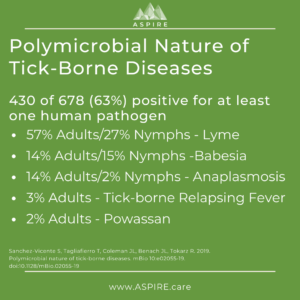Polymicrobial nature of tick-borne diseases
- 430 of 678 (63%) positive for at least one human pathogen
- 57% Adults/27% Nymphs – Lyme
- 14% Adults/15% Nymphs -Babesia
- 14% Adults/2% Nymphs – Anaplasmosis
- 3% Adults – Tick-borne Relapsing Fever
- 2% Adults – Powassan
 The deer tick (Ixodes scapularis) transmits five pathogens to humans: Lyme (Borrelia burgdorferi), Babesia (Babesia microti), Anaplasmosis (Anaplasma phagocytophilum), Tick-borne Relapsing Fever (Borrelia miyamotoi), and POWV – Powassan Virus. Tick-borne infections range from asymptomatic to fatal. The incidence rate is higher in children and the elderly. Deer ticks are a public health threat. Half the deer ticks collected in the Northeast have the Lyme bacteria. Almost a quarter have polymicrobial infections. As a result, a polymicrobial approach must be taken when diagnosing and treating tick-borne illness to make sure no infection is missed. Polymicrobial tick-borne infections complicated diagnosis in terms of testing and making a clinical diagnosis. Polymicrobial tick-borne infections make symptom severity worse as the infections can have a synergistic effect. The exposure of another tick-borne infection could alter the clinical course of a tick-borne disease.
The deer tick (Ixodes scapularis) transmits five pathogens to humans: Lyme (Borrelia burgdorferi), Babesia (Babesia microti), Anaplasmosis (Anaplasma phagocytophilum), Tick-borne Relapsing Fever (Borrelia miyamotoi), and POWV – Powassan Virus. Tick-borne infections range from asymptomatic to fatal. The incidence rate is higher in children and the elderly. Deer ticks are a public health threat. Half the deer ticks collected in the Northeast have the Lyme bacteria. Almost a quarter have polymicrobial infections. As a result, a polymicrobial approach must be taken when diagnosing and treating tick-borne illness to make sure no infection is missed. Polymicrobial tick-borne infections complicated diagnosis in terms of testing and making a clinical diagnosis. Polymicrobial tick-borne infections make symptom severity worse as the infections can have a synergistic effect. The exposure of another tick-borne infection could alter the clinical course of a tick-borne disease.
Sanchez-Vicente S, Tagliafierro T, Coleman JL, Benach JL, Tokarz R. 2019. Polymicrobial nature of tick-borne diseases. mBio 10:e02055-19. doi:10.1128/mBio.02055-19